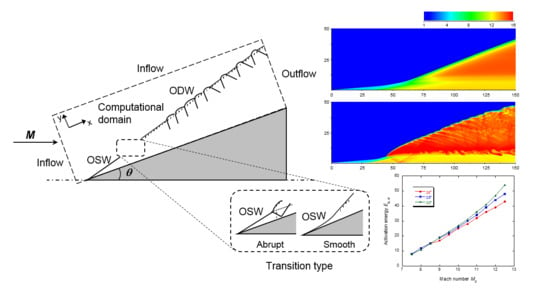The Effect of Chemical Reactivity on the Formation of Gaseous Oblique Detonation Waves
Abstract
1. Introduction
2. Computational Methods
3. Results and Discussion
4. Conclusions
Author Contributions
Funding
Conflicts of Interest
References
- Urzay, J. Supersonic combustion in air-breathing propulsion systems for hypersonic flights. Annu. Rev. Fluid Mech. 2018, 50, 593–627. [Google Scholar] [CrossRef]
- Heiser, W. Hypersonic Airbreathing Propulsion; AIAA Education Series; AIAA: Washington, DC, USA, 1994. [Google Scholar]
- Kailasanath, K. Review of propulsion applications of detonation waves. AIAA J. 2000, 38, 1698–1708. [Google Scholar] [CrossRef]
- Wolanski, P. Detonative propulsion. Proc. Combust. Inst. 2013, 34, 125–158. [Google Scholar] [CrossRef]
- Roy, G.D.; Frolov, S.M.; Borisov, A.A.; Netzer, D.W. Pulse detonation propulsion: Challenges, current status, and future perspective. Prog. Energy Combust. Sci. 2004, 30, 545–672. [Google Scholar] [CrossRef]
- Hertzberg, A.; Bruckner, A.P.; Knowlen, C. Experimental investigation of ram accelerator propulsion modes. Shock Waves 1991, 1, 17–25. [Google Scholar] [CrossRef]
- Higgins, A.J. Ram accelerators: Outstanding issues and new directions. J. Propul. Power 2006, 22, 1170–1187. [Google Scholar] [CrossRef]
- Chan, J.; Sislian, J.P.; Alexander, D. Numerically simulated comparative performance of a Scramjet and Shcramjet at Mach 11. J. Propul. Power 2010, 26, 1125–1134. [Google Scholar] [CrossRef]
- Alexander, D.C.; Sislian, J.P. A computational study of the propulsive characteristics of a Shcramjet engine. J. Propul. Power 2008, 24, 34–44. [Google Scholar] [CrossRef]
- Behrens, H.; Struth, W.; Wecken, F. Studies of hypervelocity firings into mixtures of hydrogen with air or with oxygen. Symp. (Int.) Combust. 1965, 10, 245–252. [Google Scholar] [CrossRef]
- McVey, J.B.; Toong, T.Y. Mechanism of instabilities of exothermic hypersonic blunt-body flows. Combust. Sci. Technol. 1971, 3, 63–76. [Google Scholar] [CrossRef]
- Ju, Y.; Masuya, G.; Sasoh, A. Numerical and theoretical studies on detonation initiation by a supersonic projectile. Symp. (Int.) Combust. 1998, 27, 2225–2231. [Google Scholar] [CrossRef]
- Ju, Y.; Sasoh, A.; Masuya, G. On the Detonation Initiation by a Supersonic Sphere. In Ram Accelerators; Takayama, K., Sasoh, A., Eds.; Springer: Berlin/Heidelberg, Germany, 1998. [Google Scholar]
- Vasiljev, A.A. Initiation of gaseous detonation by a high speed body. Shock Waves 1994, 3, 21–326. [Google Scholar] [CrossRef]
- Lee, J.H.S. Initiation of detonation by a hypervelocity projectile. Prog. Astronaut. Aeronaut. 1997, 173, 293–310. [Google Scholar]
- Kasahara, J.; Fujiwara, T.; Endo, T. Chapman-Jouguet oblique detonation structure around hypersonic projectiles. AIAA J. 2001, 39, 1553–1561. [Google Scholar] [CrossRef]
- Maeda, S.; Kasahara, J.; Matsuo, A. Oblique detonation wave stability around a spherical projectile by a high time resolution optical observation. Combust. Flame 2012, 159, 887–896. [Google Scholar] [CrossRef]
- Kaneshige, M.J.; Shepherd, J.E. Oblique detonation stabilized on a hypervelocity projectile. Symp. (Int.) Combust. 1996, 26, 3015–3022. [Google Scholar] [CrossRef]
- Verreault, J.; Higgins, A.J. Initiation of detonation by conical projectiles. Proc. Combust. Inst. 2011, 33, 2311–2318. [Google Scholar] [CrossRef]
- Morris, C.I.; Kamel, M.R.; Hanson, R.K. Shock-induced combustion in high-speed wedge flows. Symp. (Int.) Combust. 1998, 27, 2157–2164. [Google Scholar] [CrossRef]
- Viguier, C.; Da Silva, L.F.F.; Desbordes, D.; Deshaies, B. Onset of oblique detonation waves: Comparison between experimental and numerical results for hydrogen-air mixtures. Symp. (Int.) Combust. 1996, 26, 3023–3031. [Google Scholar] [CrossRef]
- Lu, F.K.; Fan, H.; Wilson, D.R. Detonation waves induced by a confined wedge. Aerosp. Sci. Technol. 2006, 10, 679–685. [Google Scholar] [CrossRef]
- Cambier, J.L.; Adelman, H.; Menees, G.P. Numerical simulations of an oblique detonation wave engine. J. Propul. 1990, 6, 315–323. [Google Scholar] [CrossRef]
- Ostrander, M.; Hyde, J.; Young, M.; Kissinger, R.; Pratt, D. Standing oblique detonation wave engine performance. In Proceedings of the 23rd Joint Propulsion Conference, San Diego, CA, USA, 29 June–2 July 1987. No. AIAA-87-2002. [Google Scholar]
- Adelman, H.G.; Cambier, J.L.; Menees, G.P.; Balboni, J.A. Analytical and experimental validation of the oblique detonation wave engine concept. In Proceedings of the 26th Aerospace Sciences Meeting, Reno, NV, USA, 11–14 January 1988. No. AIAA-88-0097. [Google Scholar]
- Gross, R.A. Oblique detonation waves. AIAA J. 1963, 1, 1225–1227. [Google Scholar] [CrossRef]
- Pratt, D.T.; Humphrey, J.W.; Glenn, D.E. Morphology of standing oblique detonation waves. J. Propul. Power 1991, 7, 837–845. [Google Scholar] [CrossRef]
- Ashford, S.A.; Emanuel, G. Wave angle for oblique detonation waves. Shock Waves 1994, 3, 327–329. [Google Scholar] [CrossRef]
- Emanuel, G.; Tuckness, D.G. Steady, oblique, detonation waves. Shock Waves 2004, 13, 445–451. [Google Scholar] [CrossRef]
- Li, C.; Kailasanath, K.; Oran, E.S. Detonation structure behind oblique shocks. Phys. Fluids 1994, 6, 1600–1611. [Google Scholar] [CrossRef]
- Lee, J.H.S. Detonation Phenomenon; Cambridge University Press: New York, NY, USA, 2008. [Google Scholar]
- Betelin, V.B.; Nikitin, V.F.; Smirnov, N.N.; Smirnova, M.N.; Stamov, L.I.; Tyurenkova, V.V. Using GPUs for solving problems of combustion and physicochemical transformations. Math. Models Comput. Simul. 2017, 9, 727–741. [Google Scholar] [CrossRef]
- Vanka, S.P. Computational fluid dynamics on graphics processing units. J. Fluids Eng. 2013, 135, 061401. [Google Scholar] [CrossRef]
- Smirnov, N.N.; Nikitin, V.F.; Stamov, L.I.; Nerchenko, V.A.; Tyrenkova, V.V. Numerical simulations of gaseous detonation propagation using different supercomputing architectures. Int. J. Comput. Meth. 2017, 14, 1750038. [Google Scholar] [CrossRef]
- Papalexandris, M.V. A numerical study of wedge-induced detonations. Combust. Flame 2000, 120, 526–538. [Google Scholar] [CrossRef]
- Teng, H.H.; Jiang, Z.L. On the transition pattern of the oblique detonation structure. J. Fluid Mech. 2012, 713, 659–669. [Google Scholar] [CrossRef]
- Liu, Y.; Liu, Y.S.; Wu, D.; Wang, J.P. Structure of an oblique detonation wave induced by a wedge. Shock Waves 2016, 26, 161–168. [Google Scholar] [CrossRef]
- Wang, T.; Zhang, Y.; Teng, H.H.; Jiang, Z.L.; Ng, H.D. Numerical study of oblique detonation wave initiation in a stoichiometric hydrogen-air mixture. Phys. Fluids 2015, 27, 096101. [Google Scholar] [CrossRef]
- Teng, H.H.; Ng, H.D.; Jiang, Z.L. Initiation characteristics of wedge-induced oblique detonation wave in a stoichiometric hydrogen-air mixture. Proc. Combust. Inst. 2017, 36, 2735–2742. [Google Scholar] [CrossRef]
- Ren, Z.; Wang, B.; Xiang, G.; Zhao, D.; Zheng, L. Supersonic spray combustion subject to scramjets: Progress and challenges. Prog. Aerosp. Sci. 2019, 105, 40–59. [Google Scholar] [CrossRef]
- Iwata, K.; Nakaya, S.; Tsue, M. Wedge-stabilized oblique detonation in an inhomogeneous hydrogen–air mixture. Proc. Combust. Inst. 2017, 36, 2761–2769. [Google Scholar] [CrossRef]
- Yu, M.; Miao, S. Initiation characteristics of wedge-induced oblique detonation waves in turbulence flows. Acta Astronaut. 2018, 147, 195–204. [Google Scholar] [CrossRef]
- Zhang, Y.; Teng, H.H.; Ng, H.D.; Wen, C. Transition between different initiation structures of wedge-induced oblique detonations. AIAA J. 2018, 56, 4016–4023. [Google Scholar] [CrossRef]
- Zhang, Y.N.; Gong, J.S.; Wang, T. Numerical study on initiation of oblique detonations in hydrogen–air mixtures with various equivalence ratios. Aerosp. Sci. Technol. 2016, 49, 130–134. [Google Scholar] [CrossRef]
- Liu, Y.; Wang, L.; Xiao, B.; Yan, Z.; Wang, C. Hysteresis phenomenon of the oblique detonation wave. Combust. Flame 2018, 192, 170–179. [Google Scholar] [CrossRef]
- Vlasenko, V.V.; Sabelnikov, V.A. Numerical simulation of inviscid flows with hydrogen combustion behind shock waves and in detonation waves. Combust. Explos. Shock Waves 1995, 31, 376–389. [Google Scholar] [CrossRef]
- Da Silva, L.F.F.; Desbordes, D.; Deshaies, B. Stabilization of an oblique detonation wave by a wedge: A parametric numerical study. Combust. Flame 2000, 121, 152–166. [Google Scholar] [CrossRef]
- Ng, H.D.; Radulescu, M.I.; Higgins, A.J.; Nikiforakis, N.; Lee, J.H.S. Numerical investigation of the instability for one-dimensional Chapman–Jouguet detonations with chain-branching kinetics. Combust. Theory Modell. 2005, 9, 385–401. [Google Scholar] [CrossRef]
- Yang, P.F.; Teng, H.H.; Jiang, Z.L.; Ng, H.D. Effects of inflow Mach number on oblique detonation initiation with a two-step induction-reaction kinetic model. Combust. Flame 2018, 193, 246–256. [Google Scholar] [CrossRef]
- Tang-Yuk, K.C.; Mi, X.C.; Lee, J.H.S.; Ng, H.D. Transmission of a detonation across a density interface. Shock Waves 2018, 28, 967–979. [Google Scholar] [CrossRef]
- Li, J.; Ning, J. Experimental and numerical studies on detonation reflections over cylindrical convex surfaces. Combust. Flame 2018, 198, 130–145. [Google Scholar] [CrossRef]
- Dounia, O.; Vermorel, O.; Misdariis, A.; Poinsot, T. Influence of kinetics on DDT simulations. Combust. Flame 2019, 200, 1–14. [Google Scholar] [CrossRef]
- Smirnov, N.N.; Penyazkov, O.G.; Sevrouk, K.L.; Nikitin, V.F.; Stamov, L.I.; Tyurenkova, V.V. Onset of detonation in hydrogen-air mixtures due to shock wave reflection inside a combustion chamber. Acta Astronaut. 2018, 149, 77–92. [Google Scholar] [CrossRef]
- Taylor, B.; Kessler, D.; Gamezo, V.; Oran, E.S. Numerical simulations of hydrogen detonations with detailed chemical kinetics. Proc. Combust. Inst. 2013, 34, 2009–2016. [Google Scholar] [CrossRef]
- Powers, J.M. Review of multiscale modeling of detonation. J. Propul. Power 2006, 22, 1217–1229. [Google Scholar] [CrossRef]
- Zhang, Y.; Fang, Y.; Ng, H.D.; Teng, H.H. Numerical investigation on the initiation of oblique detonation waves in stoichiometric acetylene–oxygen mixtures with high argon dilution. Combust. Flame 2019, 204, 391–396. [Google Scholar] [CrossRef]
- Radulescu, M.I.; Sharpe, G.J.; Bradley, D. A universal parameter quantifying explosion hazards, detonability and hot spot formation: χ number. In Proceedings of the Seventh International Seminar Fire & Explosion Hazards, Providence, RI, USA, 5–10 May 2013. [Google Scholar]
- Tang, J.; Radulescu, M.I. Dynamics of shock induced ignition in Fickett’s model: Influence of χ. Proc. Combust. Inst. 2013, 34, 2035–2041. [Google Scholar] [CrossRef]
- Li, C.; Kailasanath, K.; Oran, E.S. Effects of boundary layers on oblique detonation structures. In Proceedings of the 31st Aerospace Sciences Meeting & Exhibit, Reno, NV, USA, 11–14 January 1993. No. AIAA-93-0450. [Google Scholar]
- Bourlioux, A. Numerical Study of Unstable Detonations. Ph.D. Thesis, Princeton University, Princeton, NJ, USA, 1991. [Google Scholar]
- Higgins, A.J. Steady One-Dimensional Detonations. In Shock Wave Science and Technology Library; Zhang, F., Ed.; Springer: Berlin, Germany, 2012; Volume 6, Chap. 2. [Google Scholar]
- Teng, H.H.; Jiang, Z.L.; Ng, H.D. Numerical study on unstable surfaces of oblique detonations. J. Fluid Mech. 2014, 744, 111–128. [Google Scholar] [CrossRef]
- Verreault, J.; Higgins, A.J.; Stowe, R.A. Formation of transverse waves in oblique detonations. Proc. Combust. Inst. 2013, 34, 1913–1920. [Google Scholar] [CrossRef]
- Zhang, Y.; Zhou, L.; Gong, J.; Deng, X.; Ng, H.D.; Teng, H.H. Effects of activation energy on the instability of oblique detonation surfaces with a one-step chemistry model. Phys. Fluids 2018, 30, 106110. [Google Scholar]
- Teng, H.H.; Ng, H.D.; Li, K.; Luo, C.T.; Jiang, Z.L. Evolution of cellular structure on oblique detonation surfaces. Combust. Flame 2015, 162, 470–477. [Google Scholar] [CrossRef]
- Grismer, M.J.; Powers, J.M. Numerical predictions of oblique detonation stability boundaries. Shock Waves 1996, 6, 147–156. [Google Scholar] [CrossRef]
- Toro, E.F. Riemann Solvers and Numerical Methods for Fluid Dynamics, 3rd ed.; Springer: Berlin, Germany, 2009. [Google Scholar]
- Kiyanda, C.B.; Morgan, G.H.; Nikiforakis, N.; Ng, H.D. High resolution GPU-based flow simulation of the gaseous methane-oxygen detonation structure. J. Vis. 2015, 18, 273–276. [Google Scholar] [CrossRef]
- Mi, X.C.; Higgins, A.J.; Ng, H.D.; Kiyanda, C.B.; Nikiforakis, N. Propagation of gaseous detonation waves in a spatially inhomogeneous reactive medium. Phys. Rev. Fluids 2017, 2, 053201. [Google Scholar] [CrossRef]
- Mi, X.C.; Higgins, A.J.; Kiyanda, C.B.; Ng, H.D.; Nikiforakis, N. Effect of spatial inhomogeneities on detonation propagation with yielding confinement. Shock Waves 2018, 28, 993–1009. [Google Scholar] [CrossRef]
- Smirnov, N.N.; Betelin, V.B.; Nikitin, V.F.; Stamov, L.I.; Altoukhov, D.I. Accumulation of errors in numerical simulations of chemically reacting gas dynamics. Acta Astronaut. 2015, 117, 338–355. [Google Scholar] [CrossRef]
- Smirnov, N.N.; Betelin, V.B.; Shagaliev, R.M.; Nikitin, V.F.; Belyakov, I.M.; Deryuguin, Y.N.; Aksenov, S.V.; Korchazhkin, D.A. Hydrogen fuel rocket engines simulation using LOGOS code. Int. J. Hydrogen Energy 2014, 39, 10748–10756. [Google Scholar] [CrossRef]
- Ng, H.D.; Zhang, F. Detonation Instability. In Shock Wave Science and Technology Library; Zhang, F., Ed.; Springer: Berlin, Germany, 2012; Volume 6, Chap. 3. [Google Scholar]
- Gamezo, V.N.; Desbordes, D.; Oran, E.S. Formation and evolution of two-dimensional cellular detonations. Combust. Flame 1999, 116, 154–165. [Google Scholar] [CrossRef]
- Choi, J.Y.; Ma, F.; Yang, V. Some numerical issues on simulation of detonation cell structures. Combust. Explos. Shock Waves 2008, 44, 560–578. [Google Scholar] [CrossRef]
- Choi, J.Y.; Kim, D.W.; Jeung, I.S.; Ma, F.; Yang, V. Cell-like structure of unstable oblique detonation wave from high-resolution numerical simulation. Proc. Combust. Inst. 2007, 31, 2473–2480. [Google Scholar] [CrossRef]
- Teng, H.H.; Morgan, G.H.; Kiyanda, C.B.; Nikiforakis, N.; Ng, H.D. GPU-based simulation of the two-dimensional unstable structure of gaseous oblique detonations. AIP Conf. Proc. 2015, 1648, 030027. [Google Scholar]
- Gui, M.Y.; Fan, B.C. Wavelet structure of wedge-induced oblique detonation waves. Combust. Sci. Technol. 2012, 184, 1456–1470. [Google Scholar] [CrossRef]
- Mahmoudi, Y.; Karimi, R.; Deiterding, R.; Emami, S. Hydrodynamic instabilities in gaseous detonations: Comparison of Euler, Navier-Stokes, and large-eddy simulation. J. Propul. Power 2014, 30, 384–396. [Google Scholar] [CrossRef]
- Ziegler, J.L.; Deiterding, R.; Shepherd, J.E.; Pullin, D.I. An adaptive high-order hybrid scheme for compressive, viscous flows with detailed chemistry. J. Comput. Phys. 2011, 230, 7598–7630. [Google Scholar] [CrossRef]

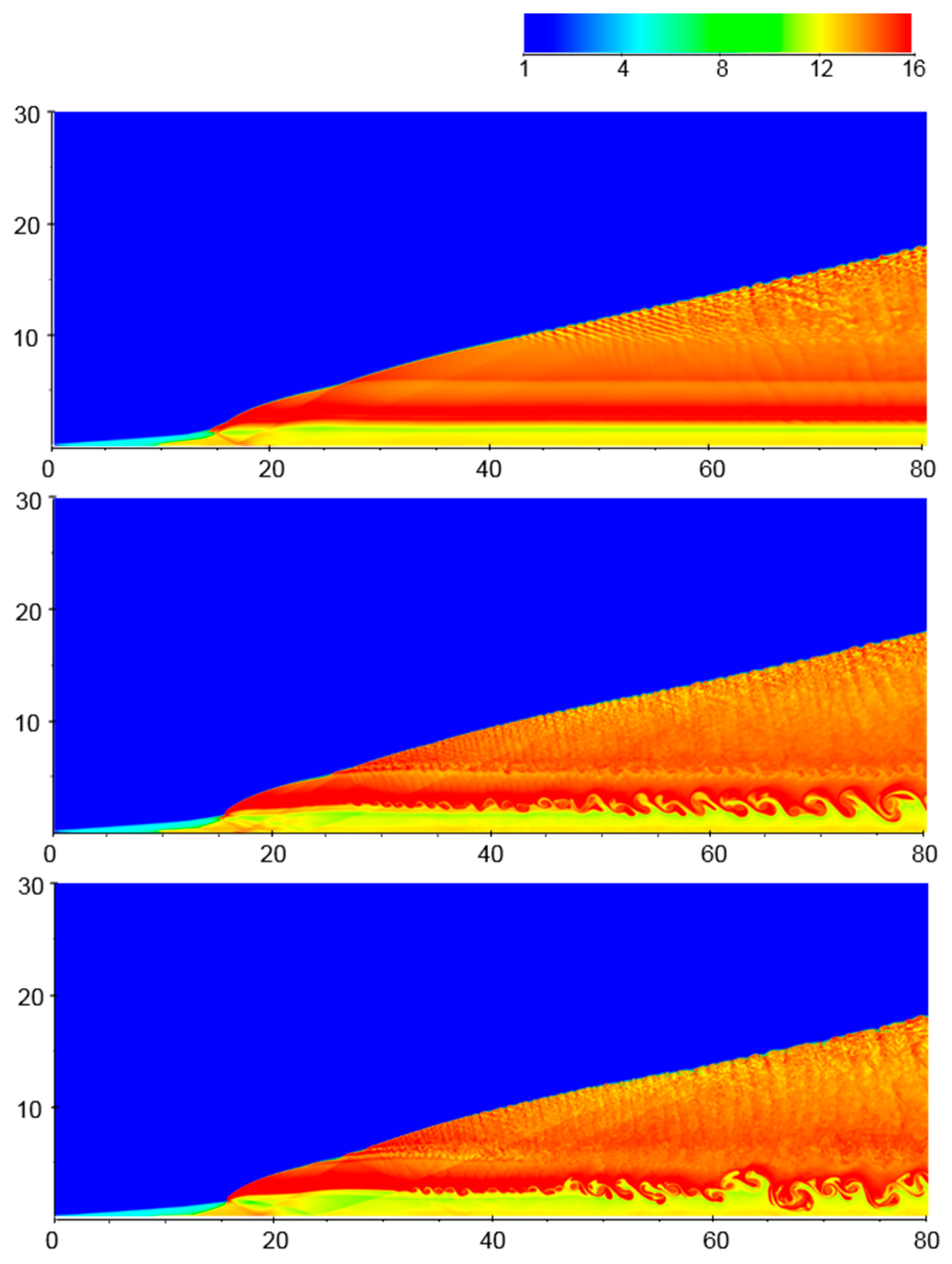

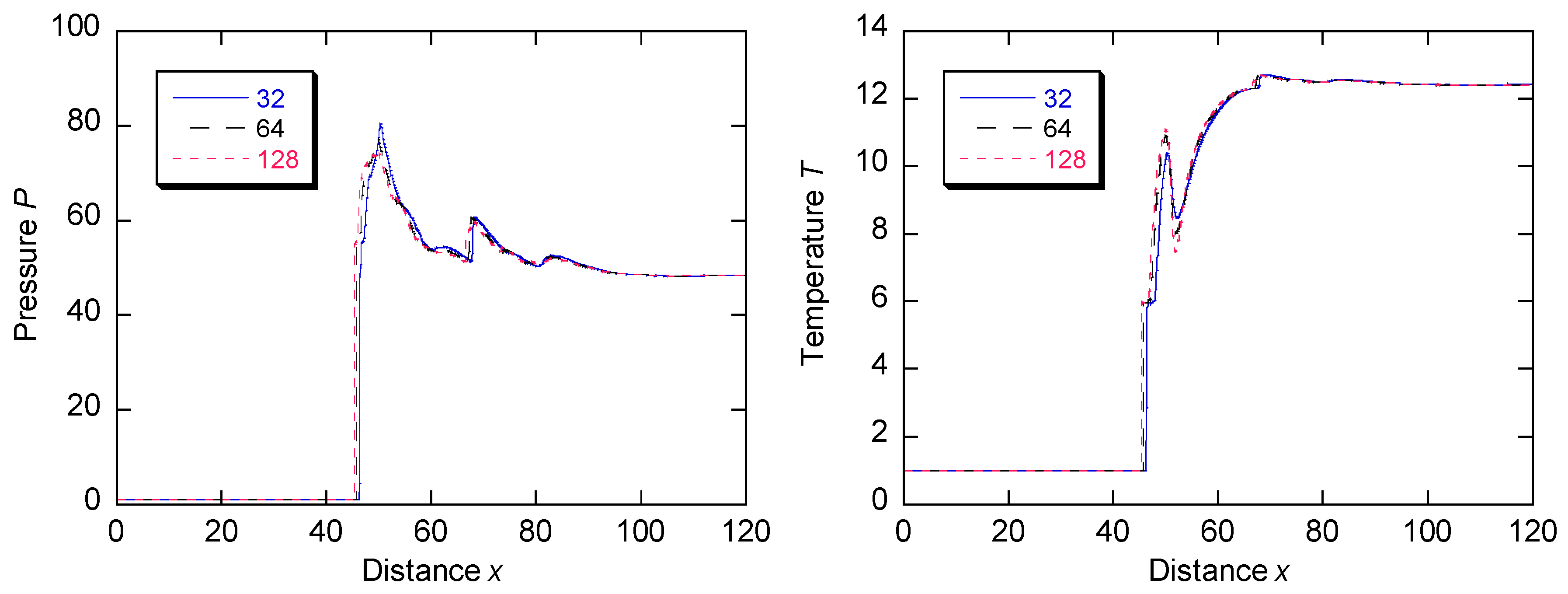
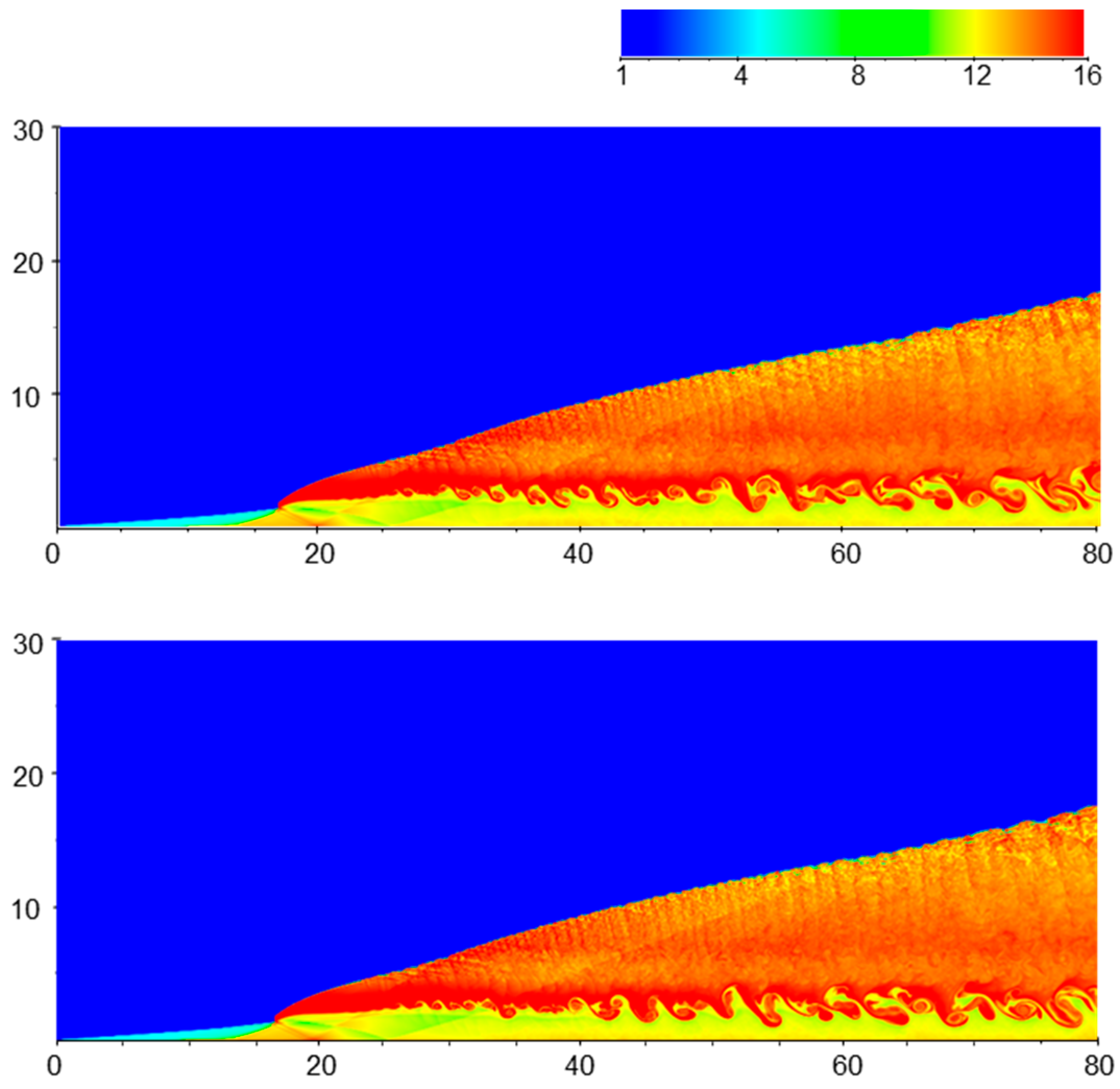
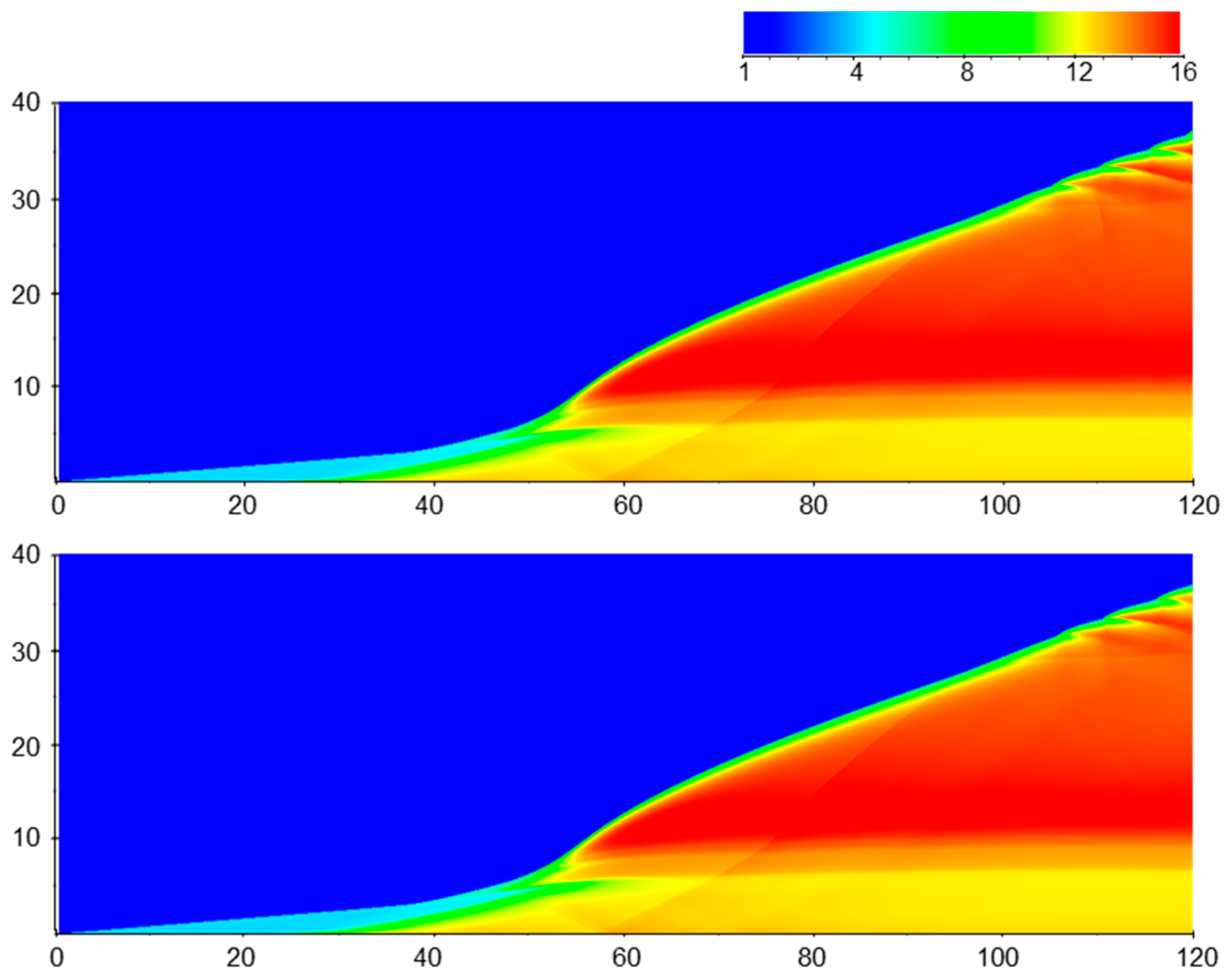
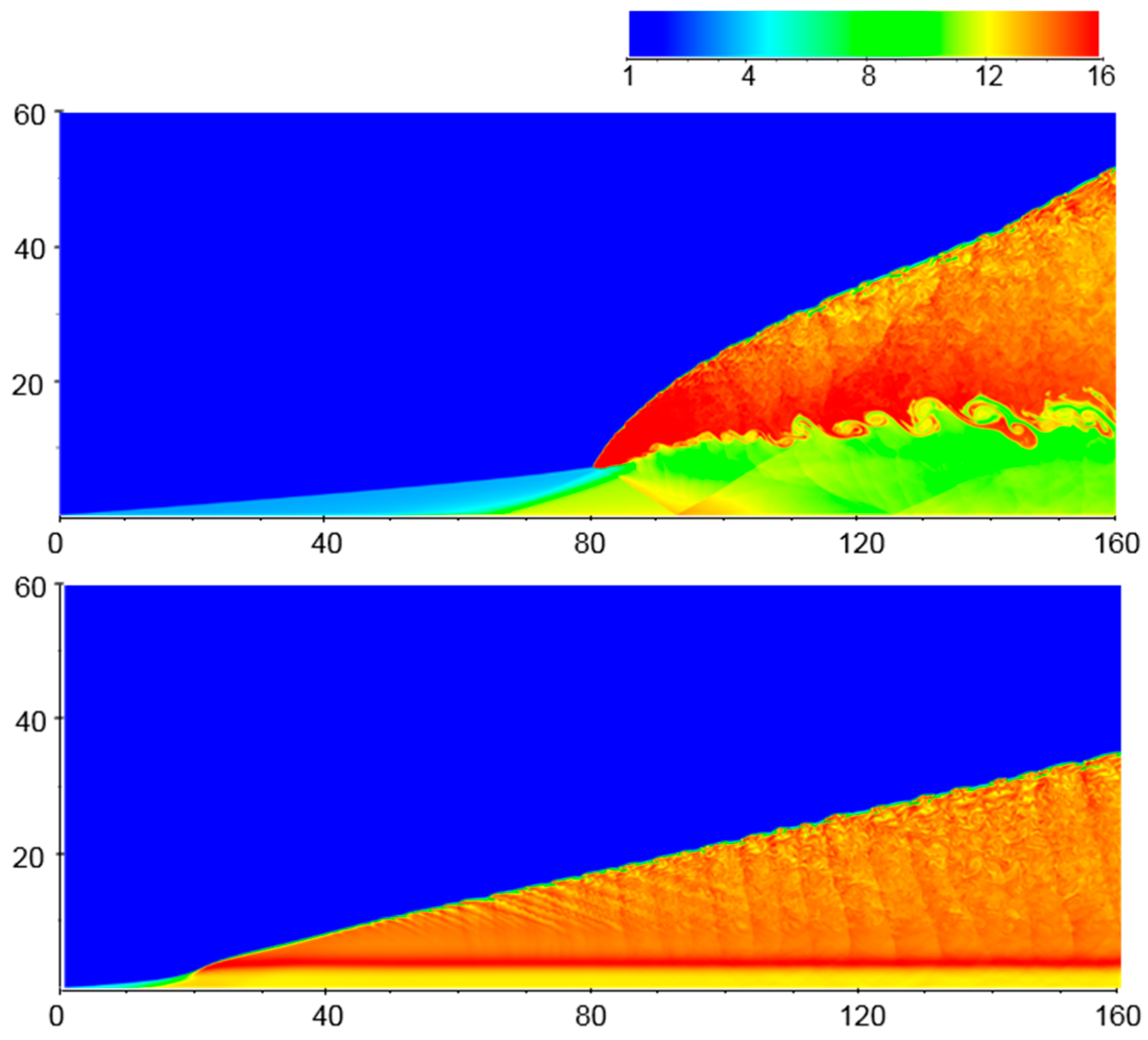
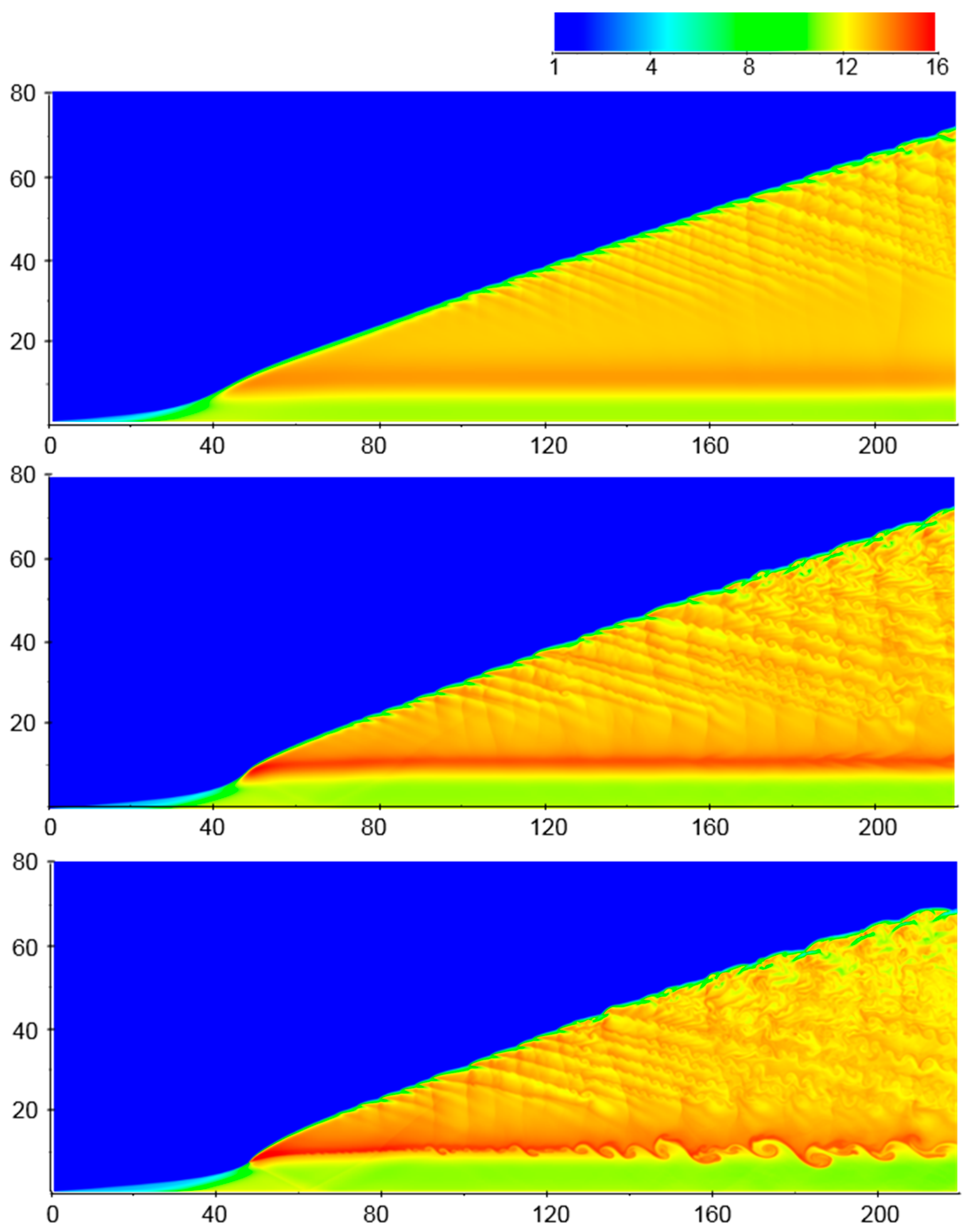

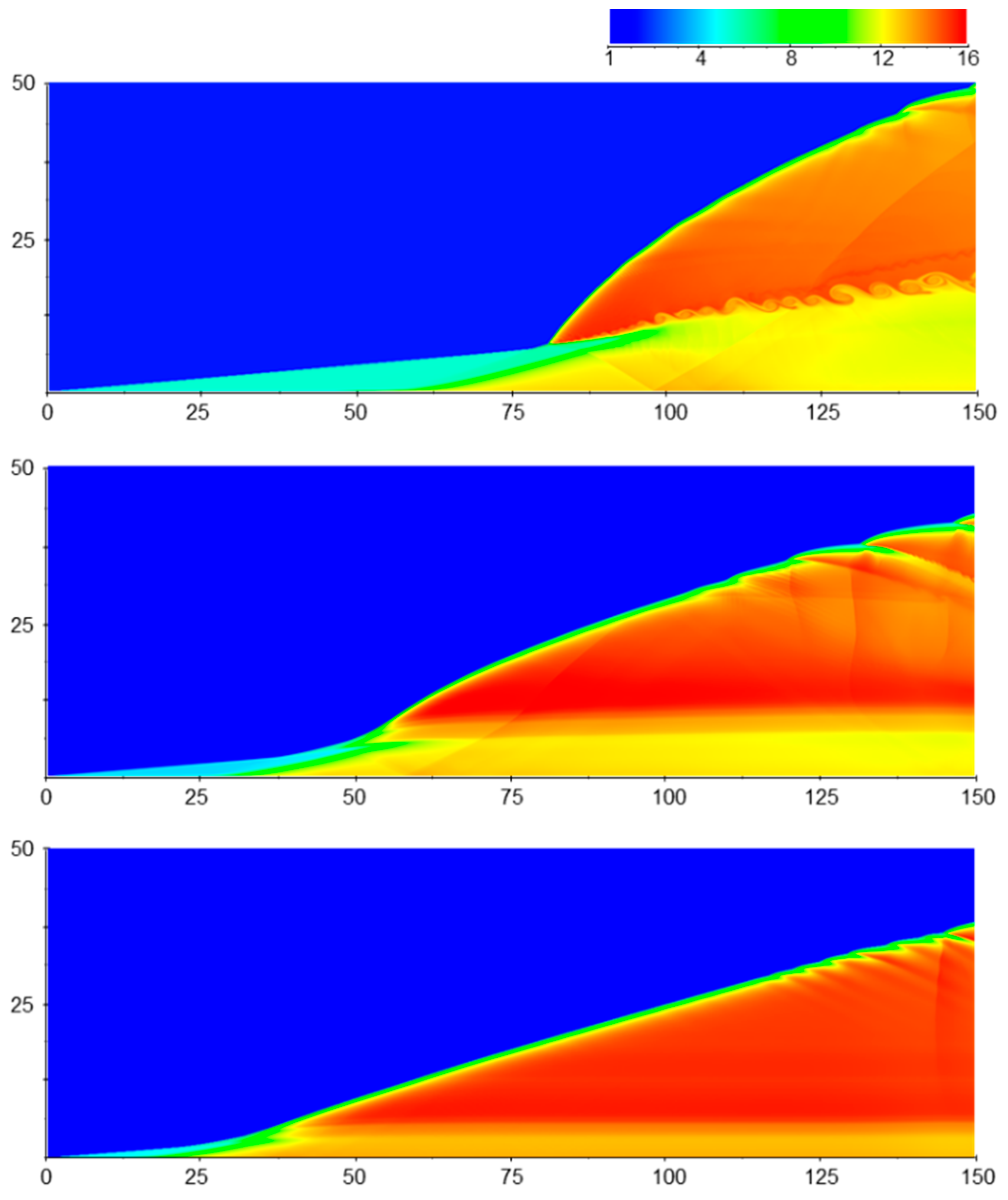
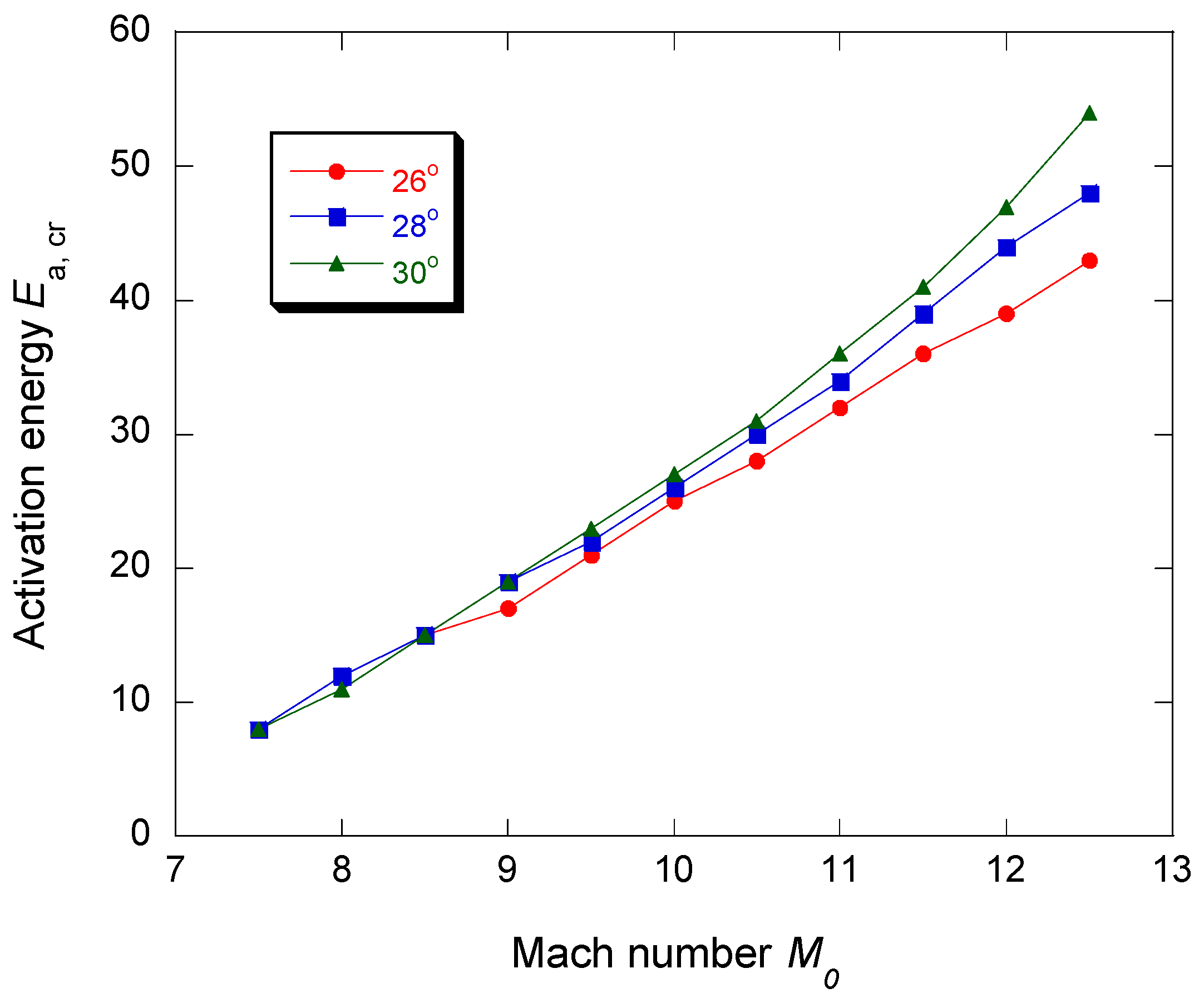
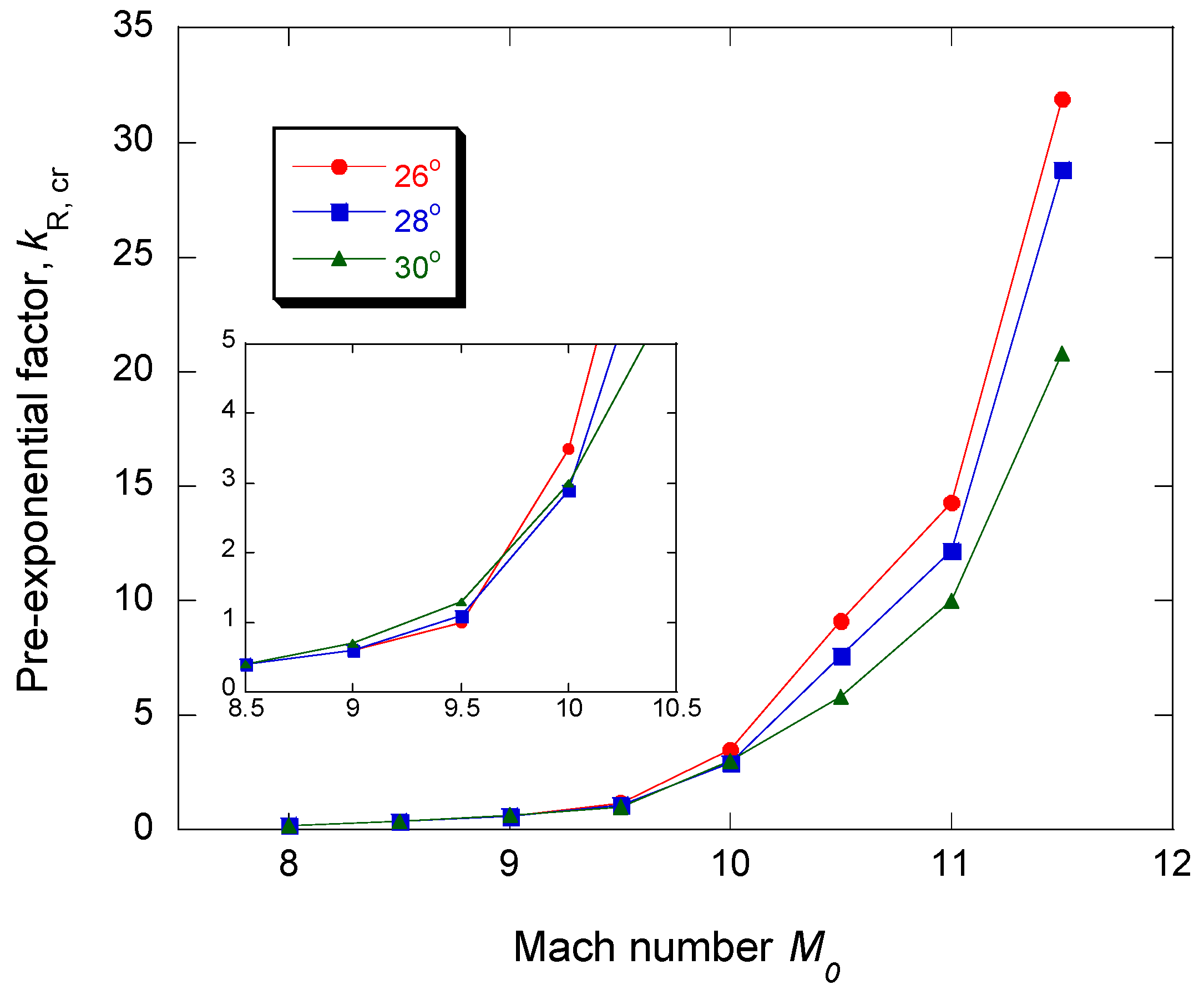
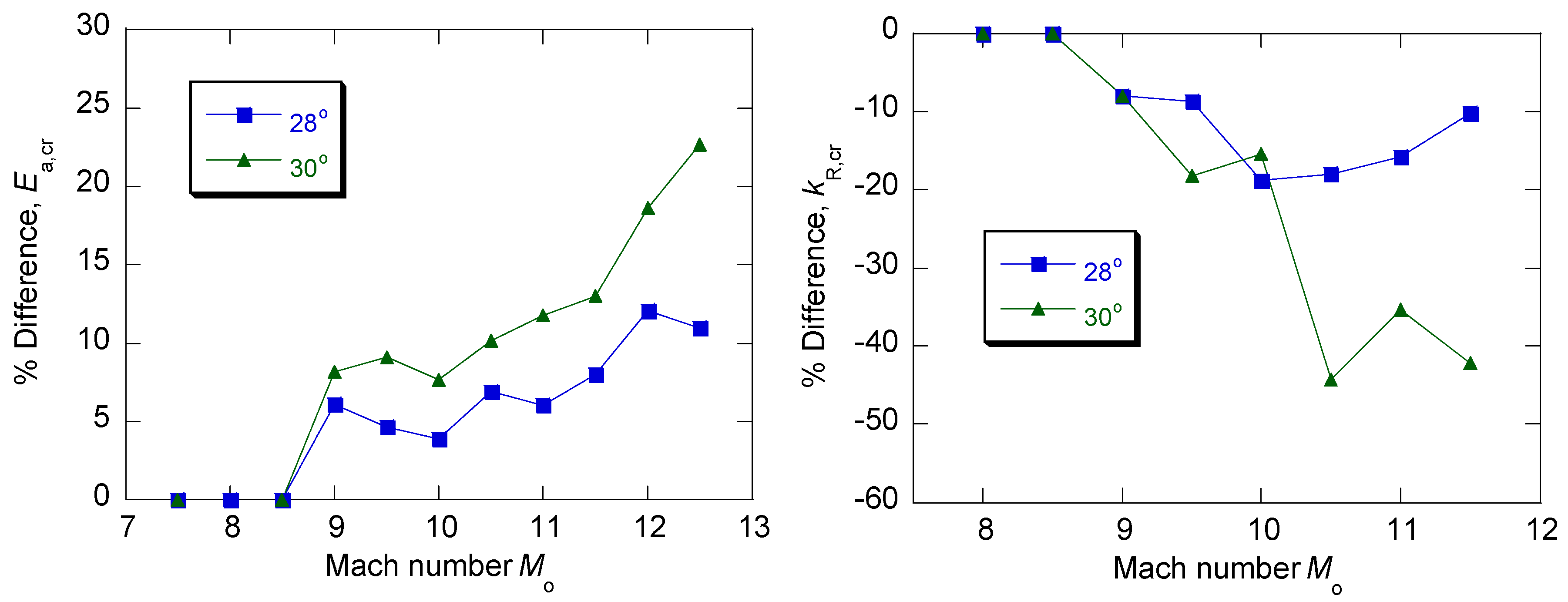

| Parameters | Values |
|---|---|
| Heat release, Q | 50 |
| Ratio of specific heats, γ | 1.2 |
| Post-shock temperature, Ts | 4.814 |
| Post-shock temperature, Ps | 42.063 |
| Post-shock particle velocity, uvn | 0.7792 |
| CJ detonation temperature, TCJ | 11.998 |
| CJ detonation pressure, PCJ | 21.531 |
| CJ detonation Mach number, MCJ | 6.2162 |
| M0 | θ | f |
|---|---|---|
| 9 | 26 | 1.20 |
| 9 | 28 | 1.27 |
| 9 | 30 | 1.36 |
| 12 | 26 | 1.50 |
| 12 | 28 | 1.63 |
| 12 | 30 | 1.77 |
© 2019 by the authors. Licensee MDPI, Basel, Switzerland. This article is an open access article distributed under the terms and conditions of the Creative Commons Attribution (CC BY) license (http://creativecommons.org/licenses/by/4.0/).
Share and Cite
Yan, C.; Teng, H.H.; Mi, X.C.; Ng, H.D. The Effect of Chemical Reactivity on the Formation of Gaseous Oblique Detonation Waves. Aerospace 2019, 6, 62. https://doi.org/10.3390/aerospace6060062
Yan C, Teng HH, Mi XC, Ng HD. The Effect of Chemical Reactivity on the Formation of Gaseous Oblique Detonation Waves. Aerospace. 2019; 6(6):62. https://doi.org/10.3390/aerospace6060062
Chicago/Turabian StyleYan, Chian, Hong Hui Teng, Xiao Cheng Mi, and Hoi Dick Ng. 2019. "The Effect of Chemical Reactivity on the Formation of Gaseous Oblique Detonation Waves" Aerospace 6, no. 6: 62. https://doi.org/10.3390/aerospace6060062
APA StyleYan, C., Teng, H. H., Mi, X. C., & Ng, H. D. (2019). The Effect of Chemical Reactivity on the Formation of Gaseous Oblique Detonation Waves. Aerospace, 6(6), 62. https://doi.org/10.3390/aerospace6060062






